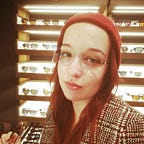My Top Works by Eileen Agar
Beginnings
Eileen Agar (1899–1901) was born in Buenos Aires to a wealthy family. Despite growing up in a rural home which fuelled her artistic beginnings, her parents were not supportive of her goals to become an artist. In an attempt to holt her ambitions, they sent her away to a series of academic schools in England. Whilst there, she was encouraged by artist and teacher Lucy Elizabeth Kemp-Welsh (1869–1958) to pursue a career in the arts. In 1920 Mabel Honor (1880–1974), a friend of the family and coincidently a friend of Impressionists such as Claude Monet (1840–1926) and Pierre Auguste-Renoir (1841–1919), saw some of her paintings and encouraged her to interview at the Slade School of Art. Her parents reluctantly agreed and she was admitted in 1921.
It was whilst in London that she developed a style inspired by both cubism and surrealism. By the end of the 1930’s she had established herself in painting, collage, assemblage and sculpture. Her work was displayed in the ‘International Surrealist Exhibition’ of 1936 alongside greats Leonor Fini, Salvador Dalí and Joan Miro.
A little about her work…
Her work focused on the natural world with particular attention being given to the coast and sea. She usually collected organic materials to feature in her work which marked a change from the man-made objects that many surrealists tended to use. She was also influenced heavily by ancient mythology, classical art, and later her own idea of womb magic.
I am not an art expert by any means, but Agar’s work really fascinates me. Looking at her creations with the naked eye delights me and I feel that they can be enjoyed without having to know every single contextual detail behind them. However, like a gift that keeps on giving, exploring the symbolism behind her work has been a joyful process and I usually find myself unwrapping layer after layer of meaning and interpretation.
Below are five of my favourite art works.
The Autobiography of an Embryo (1933–34)
As mentioned above, Agar was preoccupied with the life cycle and especially regeneration and renewal. This painting is a celebration of that as demonstrated by the repeated use of the embryonic form. Interestingly, she also makes use of the outline of a face in profile, another motif which featured heavily in her work. Amongst these are more elements of the natural world including fossils, plants, and shells. All of these things collide in a vibrant display of colour and it’s almost impossible to take your eyes away from it!
Marine Collage (1939)
Again Agar has made use of the outline of a head in profile, affectively splitting the page into four sections. However she also employs the use of classical imagery, the positioning of the statue in the lower-right quadrant is particularly atmospheric. Overlaying this are images of sea creatures such as eels and leeches. The selection of such creatures makes the painting rather sombre and unsettling in my opinion.
Angel of Anarchy (1936–1940)
This sculpture started out as a likeness of Agar’s lover Joseph Bard (1882–1975) with the feathers, silk scarves and beads being added later. The effect is certainly stunning to the naked eye! Interestingly this piece was created after the first sculpture, of the same name, went missing. Many different interpretations have been attached to Angel of Anarchy, from viewing the use of silk scarves as some form of bondage which can be perceived as either sexual, to seeing them as symbolic of the uncertainty that Agar felt in the years leading up to the Second World War, this work generates a lot of debate.
The Bird (1969)
Again, Agar’s preoccupation with nature is presented in this painting. She makes use of overlapping geometric forms and ellipses to draw attention to the dove, a symbol of hope. It’s important to note that the ellipses are shaped like eggs which could link to Agar’s ideas surrounding birth and regeneration.
Final Words…
There are many more artworks worth listing (and I may even do a part two), but the ones mentioned about give a little taster of her style and what her work stood for. She was one of the most prolific artists of her time and I hope this short introduction to her work encourages you to explore her further!
If you like what you’ve read, please follow my Instagram for more!
